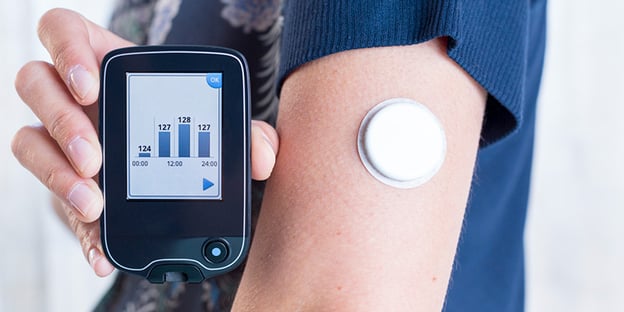Exercise is an important ingredient for a healthy life, especially when you have diabetes.
But for some, exercise is more than just a healthy habit — it’s a passion. From professional athletes to intramural soccer league members, many people with diabetes balance the condition with their love of participating in sports.
Fortunately, they have a powerful ally on their training team: A continuous glucose monitor (CGM) can help diabetic athletes perform at their best.
Below, we’ll take a look at some challenges athletes with diabetes face and how a CGM can help overcome them.
Understanding CGMs and Their Impact on Diabetic Athletes
 If you have diabetes, a continuous glucose monitor (CGM) is a game-changer. The medical device is worn on your body and tracks your glucose day and night without the need for painful finger pricks.
If you have diabetes, a continuous glucose monitor (CGM) is a game-changer. The medical device is worn on your body and tracks your glucose day and night without the need for painful finger pricks.
This lets you know instantly how your blood sugar is affected by everything you eat, how you move, your stress levels, your medication, or any number of other factors.
A CGM includes two major parts:
- Sensor: This is a small, flexible probe that is inserted just under the skin (usually on the abdomen or arm). The sensor continuously measures the glucose level in the interstitial fluid (the fluid between cells). The sensor has a small, thin filament that is inserted into the skin to measure glucose levels and it often includes a small transmitter fixed on top of it.
- Transmitter: Attached to the sensor, the transmitter sends the glucose data wirelessly to a receiver. The receiver could be a dedicated handheld device, a smartphone app, or a compatible insulin pump. The transmitter is typically reusable and needs to be charged periodically.
The Benefits of CGMs for Diabetic Athletes
CGMs help a wide range of people manage their diabetes. But for athletes with diabetes, CGMs have even more benefits.
People with diabetes need to carefully manage their blood glucose with insulin and carbohydrates before, during, and after exercise to prevent their blood sugar from dropping too low. This condition, called hypoglycemia, can result in unconsciousness, seizures, and even coma if untreated.
A CGM makes it much easier to monitor glucose levels, so athletes with diabetes can treat low blood sugar before it becomes dangerous.
CGMs can also benefit diabetic athletes in several other ways:
- Instant alerts: Blood glucose can fluctuate wildly during rigorous activity. And when you’re in the middle of a game, you need to keep your eye on the ball — not on your CGM. A CGM will beep to alert you to high and low blood sugar so you can treat it instantly, even if your focus is elsewhere.
- Valuable insights: Different kinds of exercise can affect your blood glucose in different ways. Aerobic exercises like jogging and bicycling can cause it to drop, while anaerobic exercises like weightlifting and high intensity interval training, can spike it. A CGM gives you a better view of how your activity levels affect your blood glucose, so you can spot any patterns and opt for movement that keeps you in a normal range.
- Optimized performance: By avoiding the extremes of high and low blood sugar, athletes can perform at their best. Stable glucose levels help in maintaining optimal energy levels and endurance, which are both important for athletic performance. (In fact, some athletes without diabetes are following in the footsteps of their diabetic teammates, using CGMs to track their blood sugar so they can avoid extreme high and low blood sugars for optimal performance, though the research on that strategy is still inconclusive.)
- Increased focus: CGMs can take your blood sugar management off your mind so you can focus on training and performance.
- Improved training: If you’ve ever trained for a marathon, you know it takes a lot of planning, even without factoring in blood glucose control. A CGM can make that easier by collecting data for you and your healthcare team to tailor your training to keep your glucose in a normal range for better performance. It also helps you plan meals and insulin injections around your competition schedules.
- Increased safety: Blurred vision or sudden unconsciousness in the middle of competition can be dangerous. A CGM can alert you, your coach, and your teammates to dangerous changes in your glucose levels, so you can clear the field and stay safe.
- Sleep monitoring: CGMs can track glucose levels during sleep, so athletes can ensure they are recovering properly and maintaining stable glucose levels overnight, which is essential for recovery and performance.
Your CGM and Sports Questions Answered
 If you haven’t yet incorporated a CGM into your athletic training, you probably have some questions. Many people wonder how accurate the CGM is during intense physical activity or sweating, whether the CGM is comfortable or safe to wear during contact sports, and how to ensure the CGM doesn’t fall off during activity.
If you haven’t yet incorporated a CGM into your athletic training, you probably have some questions. Many people wonder how accurate the CGM is during intense physical activity or sweating, whether the CGM is comfortable or safe to wear during contact sports, and how to ensure the CGM doesn’t fall off during activity.
Q: How accurate is a CGM during intense physical activity?
A: CGMs are generally reliable during intense activities, but fluctuations in hydration and rapid changes in glucose levels during exercise may occasionally cause discrepancies. Checking glucose levels with a traditional meter alongside the CGM during breaks can help verify accuracy if the readings seem off during intense sessions.
Q: Will the CGM be comfortable to wear during sports? Will it fall off?
A: Most users find that after a short adjustment period, the CGM is comfortable to wear. A CGM is meant to stay securely on the skin, but athletes often use extra adhesives or special covers to secure or protect them during play. Sports tape or over-patches can keep the sensor secured even during high-impact activities like running or dancing.
Q: Can the CGM device handle impact from contact sports?
A: A CGM is meant to stand up to everyday bumps, but for contact sports like hockey or football, many athletes recommend additional protective measures. A smart tip we saw on Reddit: A soccer goalkeeper uses an elbow cover to protect their CGM from being knocked around during play. Consider protective equipment, even if outside of your sport, and find what works best for you!
Q: What are the best practices for placing the CGM to avoid interference with sports gear?
A: Where you choose to place the sensor can depend on the type of sport you play. Some athletes prefer placing the CGM on the abdomen, where it can be covered by sports gear like padded shirts, or on the upper arms, where it might be less likely to interact with equipment straps or waistbands.
Q: What happens if my CGM gets wet while I play sports?
A: Most modern CGM devices are water-resistant, but prolonged exposure can still pose risks. Waterproof adhesives and covers can help, and users suggest drying off the area where the sensor is placed and checking the adhesive after activities involving water.
Q: How do I explain the device to teammates and coaches?
A: How much you share is up to you. But many diabetic athletes shared that they educate their teammates and coaches about their condition and the purpose of the CGM to foster a supportive environment. It might also be helpful in case of an emergency, where a coach or teammates need to step in to ensure your safety.
Q: Are there any specific CGM models better suited for athletic activities?
A: While most models are designed to withstand ordinary daily activities, devices like the Dexcom G6 are often praised for their durability and stronger adhesives suitable for sports.
The Future of CGMs in Sports
 Research on CGM technology is getting pretty exciting. The devices keep getting more comfortable and easier to use. New developments in sensors, for example, allow for monitoring glucose levels in less invasive ways than the usual under-the-skin methods. Companies like Dexcom are constantly tweaking their tech to make CGMs simpler and more precise.
Research on CGM technology is getting pretty exciting. The devices keep getting more comfortable and easier to use. New developments in sensors, for example, allow for monitoring glucose levels in less invasive ways than the usual under-the-skin methods. Companies like Dexcom are constantly tweaking their tech to make CGMs simpler and more precise.
There’s also a lot of work going into combining CGM data with other health monitoring tools to give a full picture of an athlete's health and performance. This includes tracking things like metabolism, muscle fatigue, and overall body stress, which can really help tailor training and recovery to each athlete’s needs.
As these technologies get better, the future could bring CGMs with advanced algorithms that predict glucose changes more accurately based on your activity level and other health markers. This would help athletes adjust their food, drink, and insulin (if they use it) to keep their glucose at the best level for top performance. We might even see CGMs that are part of overall fitness wearables, which could track everything from your heart rate to your oxygen levels and even stress markers like cortisol. This could be a game-changer in helping athletes train smarter and avoid overtraining.
Continuous glucose monitors are not just medical devices. They’re crucial tools for athletes with diabetes, ensuring they perform at their best while maintaining their health. Athletes considering CGM technology should consult with healthcare providers to integrate these devices effectively into their training routines.
Ready to unlock the power of a CGM for your sports performance? Our CGM guide walks you through the options so you can choose one that works for you.

Ready to get your CGM? We can help!



 If you have diabetes, a
If you have diabetes, a  If you haven’t yet incorporated a CGM into your athletic training, you probably have some questions. Many people wonder how accurate the CGM is during intense physical activity or sweating, whether the CGM is comfortable or safe to wear during contact sports, and how to ensure the CGM doesn’t fall off during activity.
If you haven’t yet incorporated a CGM into your athletic training, you probably have some questions. Many people wonder how accurate the CGM is during intense physical activity or sweating, whether the CGM is comfortable or safe to wear during contact sports, and how to ensure the CGM doesn’t fall off during activity. Research on CGM technology is getting pretty exciting. The devices keep getting more comfortable and easier to use. New developments in sensors, for example,
Research on CGM technology is getting pretty exciting. The devices keep getting more comfortable and easier to use. New developments in sensors, for example, 




